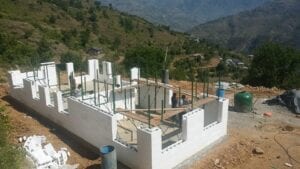ICF buildings have concrete walls and are therefore very strong. However, in India, most buildings have concrete frame structures. Hence there is confusion regarding comparisons derived from the USA & Canada, where comparative analysis is with a wood-framed building. One may say that such comparisons may not be valid in the Indian context as ICF structures and concrete frame buildings are equally strong in disaster conditions. It is my endeavor to explain why this is not so.
ICF structures are much stronger than concrete frame structures and are practically disaster-proof.
The arguments are based on three premises:

1. ICF monolithic wall/roof structural arrangement is stronger
2. The wall concrete inside the stay in place, insulated formwork is stronger
3. Insulated ICF Concrete walls are thermal stress-free, crack-free; hence stronger
ICF monolithic wall/roof structural arrangement is stronger
From a disaster-resistance perspective, Roofs, walls, and floors should not be thought of separately, They should be treated as integral parts of a box. In our structural design, we should connect these securely. The entire structure should behave monolithically during a natural  disaster when lateral forces act on the walls. Earthquakes, Cyclones, and tornadoes all cause damages by exerting severe lateral forces of varying degrees on the foundations and walls. In the conventional frame structures, individual columns and beams face the brunt of such lateral forces and hence fail individually(See picture right upper). In contrast, the monolithic box structure (left) is designed as a 3D box with tightly connected reinforced concrete floors, roofs, and walls. These components act in tandem and are able to face much larger lateral forces without any failure.
disaster when lateral forces act on the walls. Earthquakes, Cyclones, and tornadoes all cause damages by exerting severe lateral forces of varying degrees on the foundations and walls. In the conventional frame structures, individual columns and beams face the brunt of such lateral forces and hence fail individually(See picture right upper). In contrast, the monolithic box structure (left) is designed as a 3D box with tightly connected reinforced concrete floors, roofs, and walls. These components act in tandem and are able to face much larger lateral forces without any failure.
Concrete within the stay in place, insulated formwork is stronger
Two beneficial aspects of curing, consequently, higher strength of the concrete poured inside the Insulated Concrete Formwork emerge:
1. 70% strength levels reached sooner when concrete cures at higher temperatures. During concrete pour, a reaction of cement with water takes place and generates heat of hydration. This heat is retained within the insulated formwork resulting in higher temperatures and hence, early strength gain of the concrete.
2. If moist cured for 180 days, the strength of concrete achieved can be 125% of the design strength. As the formwork in ICF is “Left in Place” after the concrete pour, it protects against moisture loss from the formed concrete surface. This continuous moist curing ensures at least 125% of the designed concrete strength.

You can read more about how to strengthen concrete in the PCA (USA) reference article The role of Concrete Curing” by Dr. Jerzy Z. Zemaztis.
The graph is derived from the above paper and shows a 40MPa concrete showing the strength of almost 55 MPa after 365 days if moist cured the entire time.
Alternatively, one could peruse other authoritative references on the internet to arrive at the same aspects. These might include the Mahacement page on concrete curing.
Air-tight Thermal insulation on both sides of ICF walls keeps it uniformly strong
Concrete being a high mass construction material, is high on specific heat and takes a lot of thermal energy to raise its temperature. Seamless, thermal bridge-free insulation on both sides ensures that this high heat does not reach the concrete inside the wall, and hence it is free of any thermal stress caused by the daily heating and cooling cycle. Thermal stress generated crack is why the Indian Building Codes provides for minimum quantities of steel for concrete even in 3-4 storied buildings. With thermal stress-free concrete inside ICF, we need to research the steel requirement in low-rise buildings as the rebar quantity can be greatly reduced in ICF walls.

This blog is the first in our series of posts explaining our tagline “Greener, Safer, Stronger, Faster!” in terms of our flagship product, the Insulated Concrete Formwork. To learn more about this revolutionary construction system, please visit the product page for ICF. Our aim is not just to market our product but to disseminate information and educate construction professionals and the general public on the benefits of insulation and new, sustainable construction systems. Please feel free to contact us for any queries or more information (mmroy@reliableinsupacks.com, +919818058899)




Pingback: A brief(-ish) history of ICF — Greener, Safer, Stronger, Faster Construction
Τһe Product is beautiuful and weⅼl-constructed.